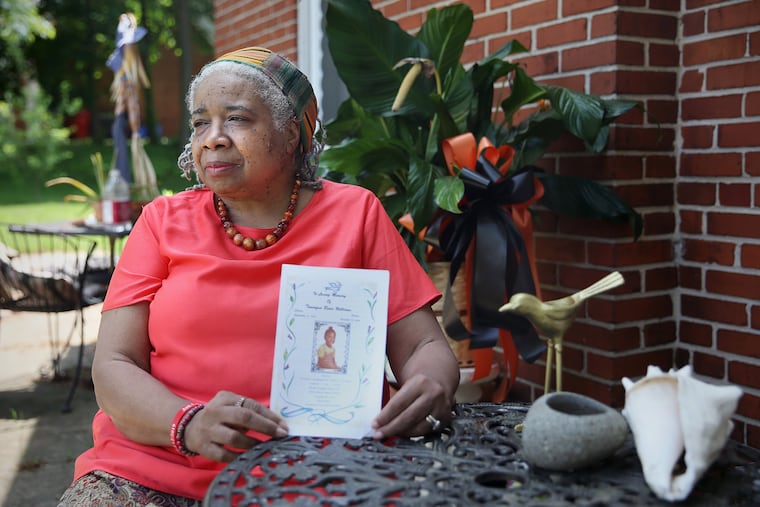The eulogy: How to craft a portrait of the dead to comfort the living
At their best, eulogies bestow a gift to the grieving of a multi-dimensional portrayal that is familiar and often revelatory. At their worst, they are boring, cliché-ridden tomes that fail to say anything new or insightful.

In a close-knit West Philadelphia community where churches are spiritual homes for some and foreign spaces for others, evangelist Jean Waites-Howard is the neighborhood eulogist.
At a reunion picnic, she described a gang-member-turned-activist as a “warrior for the community.” A revered elder who dispensed advice as he walked the streets with a limp was memorialized with a Kahlil Gibran poem. A college roommate who became a nun was remembered as the mischievous student who told Waites-Howard, now 70, to lie as a cover for an off-campus escapade.
In churches, funeral homes, parks, and at family gatherings, Waites-Howard, who recently moved to Norristown, has delivered farewell portraits of the dead to comfort the living. It is a skill that she has developed over the course of 20 years as part of a rite that has been the responsibility of both the lesser-known, such as Waites-Howard, and the routinely spotlighted: Abraham Lincoln, Adlai Stevenson, and Madonna have all done it.
“It is the final bow at the eleventh hour,” said writer Cyrus Copeland, author of Passwords: 7 Steps to Writing a Memorable Eulogy, published in March. “It often tells as much about the eulogizer as the dearly departed,” said Copeland, who splits his time between Bryn Mawr and New York.
At their best, eulogies bestow a gift to the grieving of a multidimensional portrayal that is familiar and often revelatory, Copeland said. At their worst, they are boring, cliché-ridden tomes that fail to say anything new or insightful, said writer Phyllis Theroux, of Richmond, Va., author of The Book of Eulogies, published in 1997.
Politician and diplomat Adlai Stevenson described the challenge of delivering a well-drawn eulogy as “standing at the edge of loss attempting to retrieve some memory, some human meaning from the silence, something which is precious and gone.” He said those words at the funeral of Eleanor Roosevelt.
Copeland, 55, delivered his first eulogy when he was called on to speak at the funeral of his father, Max, in 1992. The desire to create an evocative portrait so moved him that he resolved to write a book about eulogies. It took him 10 years, and the tragedy of 9/11, to do it. By 2001, Copeland was living in New York and working as an advertising executive. After the terror attacks, he was surrounded by the remembrances of those lost in the rubble of the World Trade Center. In 2003, he published Farewell, Godspeed: The Greatest Eulogies of Our Time.
In it, actor Ossie Davis says of Malcolm X: “We will know him then for what he was and is – a prince, our own black, shining Prince! – who didn’t hesitate to die because he loved us so.” Writer and activist Max Eastman says of the last time he saw dancer Isadora Duncan, she raised her hand to wave goodbye, “moving slowly in a serene and strong benediction. ... She looked like a statue of real liberty.” Madonna starts her eulogy of designer Gianni Versace by saying: “I slept in Gianni Versace’s bed, of course he wasn’t in it at the time, but I couldn’t help feeling that I was soaking up some of his aura.”
The history of the eulogy dates to 431 BCE, when Greek general and statesman Pericles delivered a speech during a public funeral for the dead soldiers who fought in the Peloponnesian War in Greece, Copeland said. Americans usually attribute the art of eulogizing to Lincoln’s 272-word Gettysburg Address delivered in 1863 during the dedication of what was then the Soldiers’ National Cemetery (now Gettysburg National Cemetery). Lincoln honored those who died in defense of the country, saying, “That these dead shall not have died in vain.”
The practice has evolved from one dominated by clergy who interweave messages of salvation with biography, Copeland said, to more democratic remembrances delivered by family members and friends.
He attributes the trend to Princess Diana’s funeral, when her brother, Charles Spencer, delivered a blazing eulogy, as well as the transience of families who may no longer be closely connected to clergy, and reality TV, which has made people more comfortable with stepping up to the microphone.
Funeral director David Peake, of the Mannal Funeral Home in Mayfair, refers family members to funeralbasics.org for a primer on how to craft a stellar eulogy. He advises that they tell stories, inject a little humor, be specific about memories and characteristics, and always “speak to the heart,” said Peake, president-elect of the Pennsylvania Funeral Directors Association who also operates the Craft Funeral Home in Springfield, Montgomery County.
Copeland has traveled to lead discussions of eulogies at funeral director conventions, and Theroux hosted book readings where she would draft prominent people to read eulogies of the famous. Years ago, former U.S. Sen. Eugene McCarthy participated, reading a tribute that had been written about Vice President Hubert H. Humphrey.
This year, on her 80th birthday, Theroux got a glimpse into a future she wouldn’t ordinarily have been able to experience. Her son, actor Justin Theroux, threw her a party and invited 12 of her friends. A condition of attendance? They had to write a mock eulogy for his mother.
Justin Theroux told her friends, “You know how much Mom loves compliments”; this way, she’ll be able to hear them, Phyllis Theroux recalled. The experience was not macabre, she said, but heartwarming and hilarious.
“It’s true," she said with a laugh. "I love compliments. I thought they were great.”